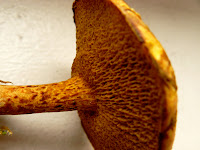A common house flower pot mushroom
It's been many years since my last mushroom post here but in the mean time a lot happened in my life, including a 4 year long stay in Las Vegas (and there are not many mushrooms there). Now that we are back in the East Coast (in Massachusetts) and there are plenty of mushrooms growing everywhere, I guess I can start posting again.
Yesterday my wife called me to show me a cluster of beautiful yellow mushrooms growing in a plant pot inside the house. The main concern was that our cats would eat them and get sick again (they ate one of ours plants once and it was not fun to have three sick cats at the same time). Given the long dry spell (literally) I wondered if I could still identify any mushrooms and if I would be able to even describe what I was seeing. Fortunately, it seems like mushroom identification skills are like riding a bike and, with a little help of my old and little identification manual ("How to identify mushrooms to Genus I: Macroscopic Features by David L. Argent) I quickly jumpstarted my rusty identification skills (it is unfortunate that the book is out of print but I guess it is probably outdated as well ;-).
So here it goes:
Date: 09/16/2023
Location: Medfield, MA
Habitat: On ground (in plant plot) with sansevieiria plants
Measurements:
Pileus diameter: 4.8 cm
Pileus height: 0.7 cm
Stipe lenght: 10.0 cm
Stipe diameter: 1.0 cm at base, 0.5 cm at middle, 0.4 cm at apex
Description:
Pileus: Citrine yellow, plane, slightly incurved with crisped margin, striate, sulcate with silky surface, moist, with white flesh, very thin, smell is non-distinctive, not tasted (I do not recommend tasting mushrooms with lepidotoid and amanitoid stature)
Hymenium: Gilled with crowded gills, free, narrow, gills have smooth edges, do not bruise
Stipe: Central, inserted, terete, tapered towards apex, semi clavate, yellow, cartilagenous, with ring on upper third (lepiotoid) , no volva
Spore print: Not taken
Impression:
With a little help from the internet and google (I searched for lepiotoid yellow mushroom in plant pot) one of my top hits was the NCSU page for Leucocoprinus birnbaumii a.ka. flowerpot parasol, a.k.a. yellow houseplant mushroom (a perfect description/name in my opinion). After a quick read it became evident that this was the identity. This mushroom, as its common name describes very well, grows in household plant pots, and likely its presence suggests over watering (after all there is decomposing organic matter in the soil). It is a toxic mushroom and is thought to cause gastrointestinal upset.
























